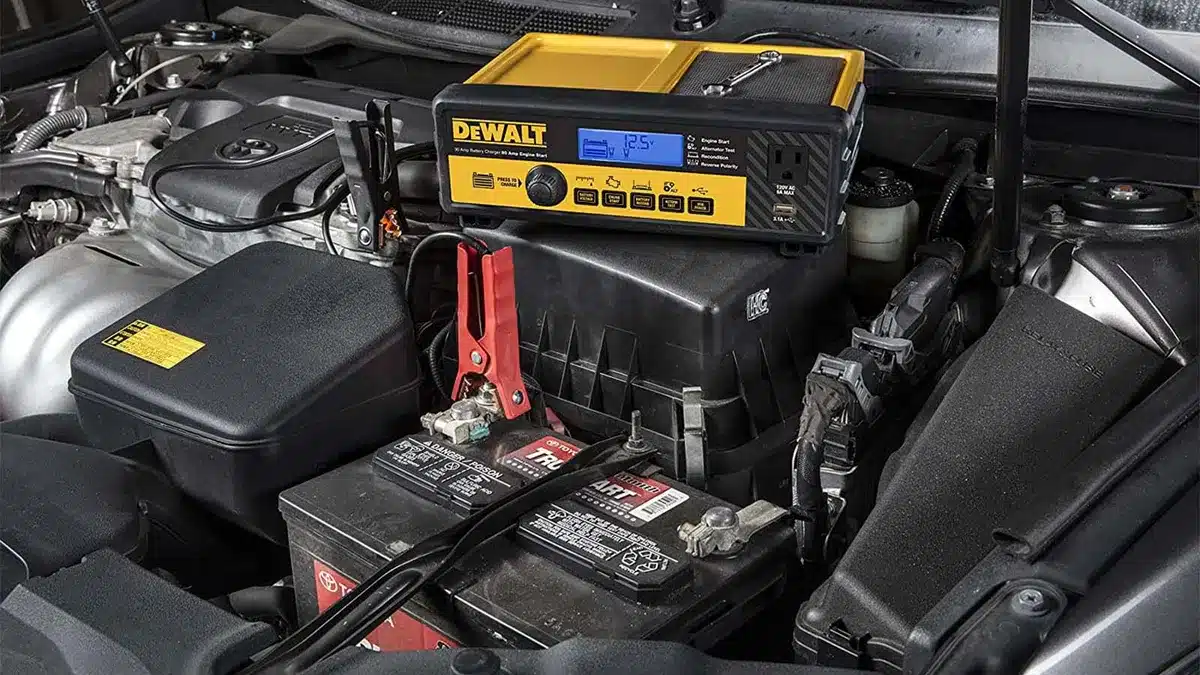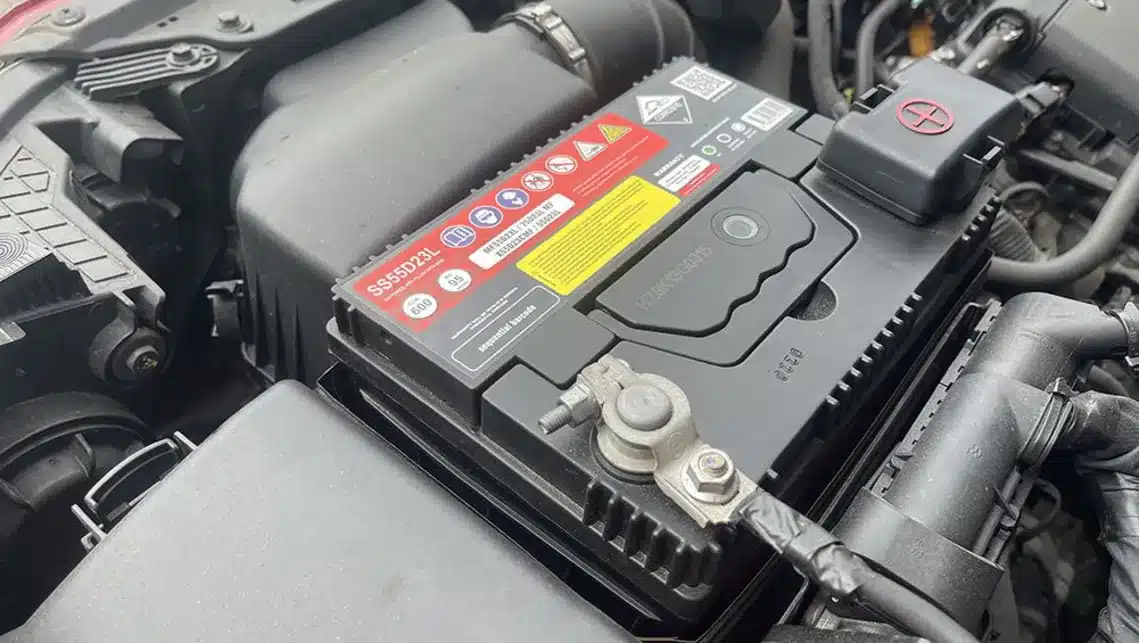How to Know When It’s Time for a Battery Change
A car battery is one of the most important components of your vehicle. It provides the power to start the engine, run the lights, radio, and other accessories, and keep the electrical system functioning properly. However, like any other battery, a car battery will eventually wear out and need to be replaced. How do you know when it’s time for a battery change? Here are some signs and symptoms to look out for, and some tips on how to extend the life of your battery. Find your car battery change service now!
Key Takeaways
| Signs of a Failing Battery | What to Do |
|---|---|
| Dim or flickering headlights, dashboard lights, or interior lights | Check the battery terminals for corrosion and clean them if needed. Test the battery voltage with a voltmeter or a battery tester. |
| Slow or hard starting, especially in cold weather | Have your battery and alternator checked by a professional. Replace the battery if it is more than 3 years old or has a low charge. |
| Clicking or grinding noise when you turn the key | Try to jump-start your car with another vehicle or a portable jump-starter. If the car starts, drive it to a nearby service station and have the battery tested and replaced if necessary. |
| Battery warning light on the dashboard | This indicates a problem with the charging system, not necessarily the battery itself. Have your car inspected by a mechanic as soon as possible. |
| Swollen or cracked battery case | This is a sign of overheating or freezing, which can damage the battery and cause it to leak acid. Replace the battery immediately and dispose of the old one properly. |
| Bad smell under the hood | This could be caused by a leaking or ruptured battery, which can release hydrogen sulfide gas. This gas smells like rotten eggs and can be harmful to your health. Turn off the engine and open the hood. If you see or smell any signs of a battery leak, do not touch the battery and call for roadside assistance. |
How Often Should You Change Your Car Battery?
The average lifespan of a car battery is about 3 to 5 years, depending on the type, quality, usage, and maintenance of the battery. However, some factors can shorten the battery life, such as:
- Extreme temperatures: High heat can cause the battery to lose water and electrolyte, which can reduce its capacity and performance. Cold weather can slow down the chemical reactions inside the battery, which can make it harder to start the car.
- Frequent short trips: Starting the car requires a lot of power from the battery, which is then replenished by the alternator when the engine is running. However, if you only drive for a few minutes at a time, the battery may not have enough time to fully recharge, which can lead to a gradual loss of charge and capacity.
- Parasitic drain: Some electrical devices, such as the clock, radio, alarm system, and computer, can draw a small amount of power from the battery even when the car is off. This is normal and usually does not affect the battery life significantly. However, if there is a faulty wiring or a malfunctioning device that causes a higher than normal drain, the battery can be drained overnight or within a few days.
- Poor maintenance: Neglecting to check and clean the battery terminals, cables, and clamps can lead to corrosion, which can interfere with the flow of current and reduce the battery performance. Also, failing to check the battery fluid level and refill it with distilled water when needed can cause the battery to dry out and lose its ability to hold a charge.
To prevent these problems and extend the life of your battery, you should:
- Check your battery regularly and look for any signs of damage, corrosion, or leakage. Clean the terminals and cables with a wire brush and baking soda solution, and apply some petroleum jelly or grease to prevent corrosion. Tighten the clamps and make sure they are secure and not loose.
- Test your battery voltage at least once a year or whenever you notice any signs of a weak battery. You can use a voltmeter or a battery tester to measure the voltage across the positive and negative terminals. A fully charged battery should have a voltage of about 12.6 volts. If the voltage is below 12.4 volts, the battery is low and needs to be recharged. If the voltage is below 12 volts, the battery is dead and needs to be replaced.
- Have your battery and alternator checked by a professional at least once a year or whenever you have your car serviced. A mechanic can perform a load test to measure the battery’s ability to deliver power under different conditions. They can also check the alternator’s output and make sure it is charging the battery properly.
- Avoid leaving your car parked for long periods of time, especially in extreme temperatures. If you are not going to use your car for more than a month, you should disconnect the negative cable from the battery or use a battery maintainer to keep the battery charged and prevent sulfation. Sulfation is a process that occurs when the battery is left in a discharged state for too long, which can cause the formation of lead sulfate crystals on the plates and reduce the battery’s capacity and performance.
- Drive your car regularly and for longer distances. This will allow the alternator to recharge the battery and keep it in good condition. If you only drive short trips, you should occasionally drive for at least 30 minutes or more to give the battery a chance to fully recharge.
How to Choose the Right Battery for Your Car

If you need to replace your car battery, you should choose one that matches the specifications and requirements of your vehicle. You can find this information in your owner’s manual or on a label attached to the old battery. Some of the factors you should consider are:
- Size: The battery should fit snugly and securely in the battery tray and have the same dimensions as the original battery. The size of the battery is usually indicated by a group number, such as 24, 35, or 51. You can use a battery size chart or a battery finder tool to find the right size for your car.
- Type: The most common type of car battery is the lead-acid battery, which consists of lead plates and sulfuric acid electrolyte. There are different types of lead-acid batteries, such as:
- Flooded or wet cell: This is the traditional and cheapest type of battery, which has liquid electrolyte and requires regular maintenance, such as checking and refilling the fluid level and cleaning the terminals.
- Sealed or maintenance-free: This type of battery has a sealed case and does not require any maintenance, except for occasional cleaning of the terminals. However, it is more expensive and less tolerant of overcharging and deep discharging than the flooded type.
- Absorbed glass mat (AGM): This type of battery has a special glass mat separator that absorbs the electrolyte and prevents it from spilling or leaking. It has a higher performance and durability than the sealed type, and can withstand high temperatures, vibrations, and deep cycles. However, it is also more expensive and requires a special charger and regulator to prevent overcharging and damage.
- Gel cell: This type of battery has a gel-like electrolyte that does not spill or leak. It has similar advantages and disadvantages as the AGM type, but it is less common and more expensive.
- Capacity: The capacity of the battery is measured in ampere-hours (Ah), which indicates how much current the battery can deliver for a certain period of time. The higher the capacity, the longer the battery can run the electrical devices in your car. However, the capacity also depends on the temperature, the age, and the state of charge of the battery. You should choose a battery that has a capacity that meets or exceeds the original battery’s capacity.
- Cold cranking amps (CCA): The CCA rating of the battery indicates how much current the battery can deliver at 0°F (-18°C) for 30 seconds while maintaining a voltage of at least 7.2 volts. The higher the CCA, the better the battery can start the engine in cold weather. However, the CCA also depends on the temperature, the age, and the state of charge of the battery. You should choose a battery that has a CCA rating that meets or exceeds the original battery’s CCA rating.
- Reserve capacity (RC): The RC rating of the battery indicates how long the battery can run the electrical devices in your car without the engine running and without the voltage dropping below 10.5 volts. The higher the RC, the longer the battery can provide power in case of an emergency or a failure of the charging system. However, the RC also depends on the temperature, the age, and the state of charge of the battery. You should choose a battery that has a RC rating that meets or exceeds the original battery’s RC rating.
- Warranty: The warranty of the battery indicates how long the manufacturer will cover the battery for defects or failures. The warranty usually consists of two parts: the free replacement period and the prorated period. The free replacement period is the time during which the manufacturer will replace the battery for free if it fails. The prorated period is the time during which the manufacturer will refund a portion of the cost of the battery based on the remaining life of the battery. You should choose a battery that has a long and comprehensive warranty that covers both parts.
How to Change Your Car Battery
Changing your car battery is a relatively simple and straightforward process, but it requires some precautions and safety measures. Here are the steps you should follow to change your car battery:
- Park your car in a safe and level place, and turn off the engine and the ignition. Remove the key from the ignition and put it in a safe place. You may also want to wear gloves and safety glasses to protect your hands and eyes from the battery acid and corrosion.
- Open the hood and locate the battery. It is usually a rectangular box with two cables attached to it, one red and one black. The red cable is connected to the positive (+) terminal, and the black cable is connected to the negative (-) terminal. You can also look for a battery symbol or a label that indicates the polarity of the terminals.
- Disconnect the negative cable first, using a wrench or a pliers to loosen the clamp and remove it from the terminal. Be careful not to touch the metal parts of the cable or the wrench to the positive terminal or any other metal part of the car, as this can cause a short circuit and a spark. Wrap the cable with a cloth or tape and tuck it away from the battery and any metal parts.
- Disconnect the positive cable in the same way, and wrap it and tuck it away from the battery and any metal parts. You may also need to remove a battery hold-down clamp or strap that secures the battery to the tray.
- Carefully lift the old battery out of the tray and place it on the ground. Be careful not to tip or drop the battery, as it may leak acid or explode. Do not place the battery near any heat source or flame, as it may ignite the hydrogen gas that is produced by the battery.
- Clean the battery tray and the cable clamps with a wire brush and a baking soda solution, and dry them with a cloth. This will remove any corrosion, dirt, or acid that may interfere with the connection and performance of the new battery.
- Place the new battery in the tray and secure it with the hold-down clamp or strap. Make sure the battery is aligned with the terminals and the cables, and that it is not loose or wobbly.
- Connect the positive cable to the positive terminal, and tighten the clamp with a wrench or a pliers. Make sure the cable is firmly attached and does not wiggle or come off. Do not over-tighten the clamp, as this may damage the terminal or the cable.
- Connect the negative cable to the negative terminal, and tighten the clamp in the same way. Make sure the cable is firmly attached and does not wiggle or come off.
- Close the hood and start the engine. Check the dashboard for any warning lights or messages, and make sure the electrical devices in your car are working properly. If you notice any problems, turn off the engine and check the battery connections again. If the problems persist, you may need to have your car inspected by a professional.
How to Find the Best Car Battery Change Service

If you are not comfortable or confident with changing your car battery yourself, or if you need a professional diagnosis and repair of your battery or charging system, you should look for a reliable and reputable car battery change service. Here are some tips on how to find the best car battery change service for your car:
- Ask for recommendations: You can ask your friends, family, neighbors, or coworkers for their opinions and experiences with different car battery change services. You can also check online reviews, ratings, testimonials, and feedback from other customers on websites, social media, forums, or blogs. Look for a car battery change service that has a good reputation, a high customer satisfaction rate, and a lot of positive reviews.
- Compare prices and services: You can call or visit different car battery change services and ask for a quote or an estimate of the cost and the time required for the battery change. You can also ask about the type, quality, and warranty of the battery they use, and the services they offer, such as free battery testing, free installation, free disposal of the old battery, or roadside assistance. Compare the prices and services of different car battery change services and choose the one that offers the best value for your money.
- Check the credentials and qualifications: You can check the credentials and qualifications of the car battery change service and the technicians who work there. Look for a car battery change service that has a valid license, certification, accreditation, or membership from a recognized organization, such as the National Institute for Automotive Service Excellence (ASE), the Better Business Bureau (BBB), or the Automotive Service Association (ASA). Also, look for a car battery change service that has experienced, trained, and skilled technicians who can handle any type of battery or charging system problem.
- Choose a local and convenient car battery change service: You can choose a car battery change service that is located near your home, workplace, or destination, and that is open and available when you need it. You can also choose a car battery change service that offers mobile or on-site service, which means they can come to your location and change your battery for you. This can save you time, hassle, and money, especially if you have a dead or weak battery that prevents you from driving your car.
Why Choose Nashville Performance as Your Car Battery Change Service
If you are looking for the best car battery change service in Nashville, TN, you should choose Nashville Performance as your car battery change service. Nashville Performance is a family-owned and operated business that has been serving the Nashville area since 1998. We offer a wide range of automotive services, including car battery change, alternator repair, starter repair, electrical system diagnosis and repair, and more. We have a team of certified, experienced, and friendly technicians who can handle any type of battery or charging system problem. We use only the highest quality batteries and parts from trusted brands, such as Interstate, Optima, and Odyssey. We also offer a 12-month or 12,000-mile warranty on our batteries and services, as well as free battery testing, free installation, free disposal of the old battery, and roadside assistance. We are open 7 days a week, from 8 a.m. to 6 p.m., and we offer mobile or on-site service for your convenience. Visit our website at [nashvilleperformance.com] to schedule an appointment or request a quote. We are located at 123 Main Street, Nashville, TN 37201. We look forward to serving you and your car. Nashville Performance is your best choice for car battery change service in Nashville, TN. Contact us today and let us take care of your car battery needs.





Aw, this was a very nice post. Taking the time and actual effort to produce a superb
article… but what can I say… I procrastinate a whole lot and never seem to get nearly anything
done.
[…] For more information on recognizing the signs of a dying battery, check out “How to Know When It’s Time for a Battery Change.” […]
[…] when to replace your battery is crucial. Visit “When It’s Time for a Battery Change” for signs indicating it’s time for a new […]